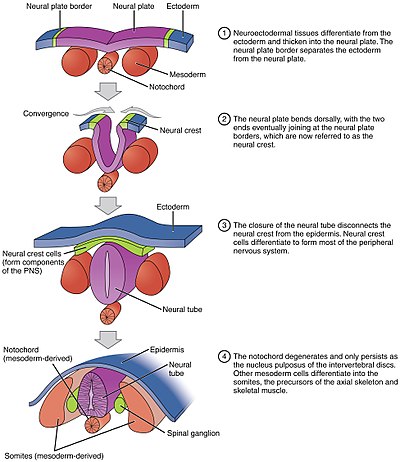
Back تكون الأنبوب العصبي Arabic Neurulacija BS Neurulació Catalan Neurulation German Neurulación Spanish Neurulatsioon Estonian Neurulaatio Finnish Neurulation French Neuruláció Hungarian Neurulazione Italian
| Neurulation | |
|---|---|
 Transverse sections that show the progression of the neural plate to the neural groove from bottom to top | |
| Identifiers | |
| MeSH | D054261 |
| Anatomical terminology | |
Neurulation refers to the folding process in vertebrate embryos, which includes the transformation of the neural plate into the neural tube.[1] The embryo at this stage is termed the neurula.
The process begins when the notochord induces the formation of the central nervous system (CNS) by signaling the ectoderm germ layer above it to form the thick and flat neural plate. The neural plate folds in upon itself to form the neural tube, which will later differentiate into the spinal cord and the brain, eventually forming the central nervous system.[2] Computer simulations found that cell wedging and differential proliferation are sufficient for mammalian neurulation.[3]
Different portions of the neural tube form by two different processes, called primary and secondary neurulation, in different species.[4]
- In primary neurulation, the neural plate creases inward until the edges come in contact and fuse.
- In secondary neurulation, the tube forms by hollowing out of the interior of a solid precursor.
- ^ Larsen WJ. Human Embryology. Third ed. 2001.P 86. ISBN 0-443-06583-7
- ^ "Chapter 14. Gastrulation and Neurulation". biology.kenyon.edu. Retrieved 2 February 2016.
- ^ Nielsen, Bjarke Frost; Nissen, Silas Boye; Sneppen, Kim; Mathiesen, Joachim; Trusina, Ala (February 21, 2020). "Model to Link Cell Shape and Polarity with Organogenesis". iScience. 23 (2): 100830. Bibcode:2020iSci...23j0830N. doi:10.1016/j.isci.2020.100830. PMC 6994644. PMID 31986479.
- ^ Wolpert, Lewis; Tickle, Cheryll; Arias, Alfonso Martinez (2015). Principles of development (Fifth ed.). Oxford, United Kingdom: Oxford University Press. p. 393. ISBN 9780198709886.
© MMXXIII Rich X Search. We shall prevail. All rights reserved. Rich X Search